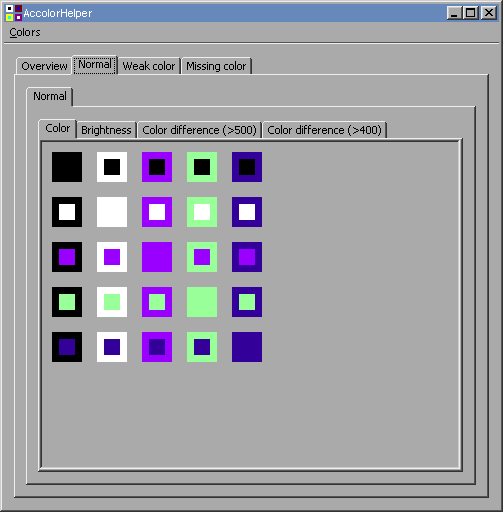
AccolorHelper (accessible color helper) is a simple tool which helps you determine whether the colors you want to use can be distinguished from each other by people with color deficiencies. It will do so by showing the color as seen by these people. It will also calculate brightness and color difference values for all color combinations of your colors, so the rating of a color combination is not dependent on the viewer.
Eight color deficiencies are simulated by AccolorHelper. These deficiencies can be divided into three categories:
The following table (mostly copied from the color vision page of Mark McCourt, Department of Psychology, North Dakota State University) shows how often each deficiency occurs:
| Deficiency | Male | Female | Population |
|---|---|---|---|
| Anomalous trichromat | |||
| Protanomaly (weak red) | 1.3% | rare | 0.7% |
| Deuteranomaly (weak green) | 5.0% | 0.4% | 2.7% |
| Tritanomaly (weak blue) | rare | rare | rare |
| Dichromat | |||
| Protanopia (no red) | 1.3% | rare | 0.7% |
| Deuteranopia (no green) | 1.2% | rare | 0.6% |
| Tritanopia (no blue) | rare | rare | rare |
| Monochromat | |||
| Atypical monochromatic (weak color) | rare | rare | rare |
| Typical monochromatic (no color) | rare | rare | rare |
| Total | |||
| Total | 8.8% | 0.4% | 4.6% |
As you can see tritan (affecting blue) and monochromatic deficiencies are rare. Protan (affecting red) and deutan (affecting green) deficiencies are common, affecting about 1 in 22 people. Of this 4.6% of the population the majority is male.
The formulas to calculate the dichromatic deficiencies are taken from Hans Brettel's Computerized Simulation of Color Appearance for Dichromats.
The formula to calculate typical monochromacy is to use the brightness value of a color as specified by the Web Accessibility Initiative (WAI) for the red, green and blue values. The formula for the brightness value is hard to find, it is described in Techniques For Accessibility Evaluation And Repair Tools (AERT).
The formulas to calculate the weak color deficiences are taken from the pages of Cal Henderson. They average the dichromatic colors and monochromatic colors with the original colors with a 1:1 and 4:1 ratio respectively.
To be able to use AccolorHelper you need Java 5.0 or a newer version. You can download Java at www.java.com. After installing Java you can download Accolorhelper from the files section. The latest version is 1.02.01.
You can start AccolorHelper by double clicking on the JAR file. It is also possible to start AccolorHelper from
the command line using: java -jar AccolorHelper.jar (the name of the JAR file can differ from the
name used here). If started from the command line you can pass a list of colors in hexadecimal RGB format, e.g.
FF0000 00FF00 0000FF (pure red, green and blue respectively).
After starting (without a list of colors) the following window will appear:

You can change the colors by choosing Colors/Edit....The following window will appear. Black and
white have already been added in this screenshot. As you can see you can label colors so you know what they are
used for in your project:

The overview tab shows you nine rows of colors. Each row contains the colors from the color list. The first row shows the colors as seen by people without deficiencies. The other rows show the effect of color definiciencies on the colors.

When you click on the 2nd to 4th tabs subtabs will appear. Each subtab corresponds to a row of colors on the first tab, and has further subtabs. The first innermost tab will show you all possible foreground and background combinations of the colors:

The 2nd to 4th innermost tabs show the brightness and color difference values between the colors. These values are calculated using the formulas of the WAI (again, see AERT for the formulas). Preferred color combinations, having a difference greater than a certain value, are shown in a larger, bold font.
For the brightness difference the value must be greater than 125. The minimum value of the WAI for the color difference, 500, severely limits the number of color combinations. Because of this a separate tab shows the color combinations with a color difference value of at least 400, giving you more color combinations to choose from.

You can click on a color combination or a difference value. This will select that color combination and the color combination where the colors are swapped:

The same color combinations are selected on all the other subtabs. This allows you to easily see how a color combination looks and is rated on another tab:

Clicking on a selected cell will deselect it.
On the overview tab you can click on a color column. This will select all color combinations of which that color is one of the colors. Clicking on a previously selected column again will deselect all color combinations.
In the menu you can find actions which allow you to open and save color lists.
The file format of AccolorHelper is very simple. Just put a hexadecimal RGB value on each line. The label of a color is added after the RGB value, and a space must separate the RGB value and the label. For example:
000000 Main text AAAAAA 6688BB Links FFFFFF